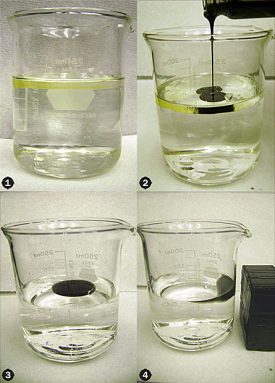Nanomagnets corral oil
Scientists may have found a clever way to clean up oil spills -- with magnets.
By Emily Sohn
You’ve probably seen some of the cool things magnets can do. Place one near a paper clip, and the clip zooms across the table toward the magnet. Hold one magnet near another, and the second one mysteriously darts in the opposite direction. If you didn’t know about science, magnet tricks might seem like magic tricks.
Now, scientists have discovered another magnetic trick. By mixing unbelievably small magnets with oil, bigger magnets can be used to move the oily globs around. The trick isn’t just cool to watch. Some day, the technique could help clean up messy oil spills in the sea mistakenly dumped by ships.

Researchers at Carnegie Mellon University in Pittsburgh make teeny tiny magnets out of two metals: iron and cobalt. Unlike the palm-sized magnets you may have played with in school, these magnets are measured in nanometers. One nanometer equals one-billionth of a meter. That may be hard to picture, so think of this: A human hair is about 80,000 nanometers wide.(Read this story to learn more.)
To simulate an oil spill in the ocean, the CMU scientists plopped a few drops of mineral oil onto the surface of some water in a petri dish, a small container used in a lab. The scientists dyed the oil blue to make it stand out.
Next, they mixed a bunch of tiny nanomagnets into another batch of oil, creating a black liquid. Using an eye dropper, the scientists added some of this syrupy black stuff to the petri dish. Almost immediately, the black syrup surrounded the blue oil in the center of the dish. Afterward, the researchers placed a strong magnet next to the dish. Right away, the nanomagnet-filled syrup floated toward the big magnet. More importantly, it brought the blue oil with it.
One hope is that the technique might some day help clean up oil spills. Using vats of nanomagnets and large magnetic fences, workers might round up oil spills at sea and prevent them from harming the environment and killing animals.
Many challenges remain, however. Nanomagnets are expensive to make, for one thing, and it would take a lot of them to clean up a big spill. In addition, scientists will want to find a way to gather the little magnets back up once they’ve finished their work. They’ll also need to figure out what to do with the oil once it’s been gathered and moved.
For now, what’s exciting is that the CMU scientists have overcome the first hurdle: showing that the idea can work.







